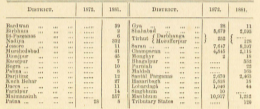Bhar
This article is an extract from
THE TRIBES and CASTES of BENGAL. Ethnographic Glossary. Printed at the Bengal Secretariat Press. 1891. . |
NOTE 1: Indpaedia neither agrees nor disagrees with the contents of this article. Readers who wish to add fresh information can create a Part II of this article. The general rule is that if we have nothing nice to say about communities other than our own it is best to say nothing at all.
NOTE 2: While reading please keep in mind that all articles in this series have been scanned from a very old book. Therefore, footnotes have got inserted into the main text of the article, interrupting the flow. Readers who spot scanning errors are requested to report the correct spelling to the Facebook page, Indpaedia.com. All information used will be duly acknowledged.
Bhar
a small Dravidian caste of Western Bengal and Chota Nagpur, most of whom are cultivators, while a few occupy the position of hereditary personal servants to the Rajas of l'achete. The Bbars are divided into two sub-castes, Maghaya and Bangali, the members of which do not intermarry. Their sections show a ourious mixture of the totemistic and eponymous types, whioh may perhaps indicate that the caste is undergoing the process of gradual conversion to Hinduism and incorporation into the regular caste system. This view is borne out) on the whole, by their domestic institutions, which appear to be in a similar state of transition.
Thus the remarriage of widows has been discarded, and the license of di vorce, conceded so freely by the non-Aryan races, entirely done away with; while adult-marriage still survives as a relic of the past, side by side with the growing usage of infant-marriage. It deserves notice that in this respect the Bhars form an exception to the usual course of development. It may be laid down as a general rule that the adoption of infant-marriage is the first step taken in the direction of conformity to orthodox usage, while the prohibition of widow-marriage usually follows as a later stage. the Ehars, however, have completely given up widow-marriage, while still recognizing the marriago of adults as permissible for those who cannot afford to marry their daughters as infants.
For the rest they appear in all respects to follow the usages of orthodox Hindns: professing the Hindu religion, employing Brah-mans, bnrning their dead, and performing their S1'ridd/" on the thirtieth day after death. In the matter of inheritance they deviate slightly from the standard school, in that they give the eldest son an extra share (Jeth-angs) of the property. This, however, is not uncommon in Western BeIfgal, and we may hazard the conjecture that it has some connexion with the custom of primogeniture which governs the succession to many of the large estates in that part of the country. the connexion of the Bhars with the Pachete family has probably tended to raise their general sooial position. They rank in Manbhum with Tamolis and Mairaa, and the higher castes can take water from their hands.
The following statement shows the number and distribution of Bhars in the Lower Provinces in 187~ and 1881. It includes the Bhars of Behar, a Hinduised branoh of the original stook, who disown all connexion with the Bhars of Western Bengal, and claim affinity with the Bhars of the N orth-Western Provinces. A full acoount of the latter is given in Mr. Crooke's Ethnographical Hand-book.
